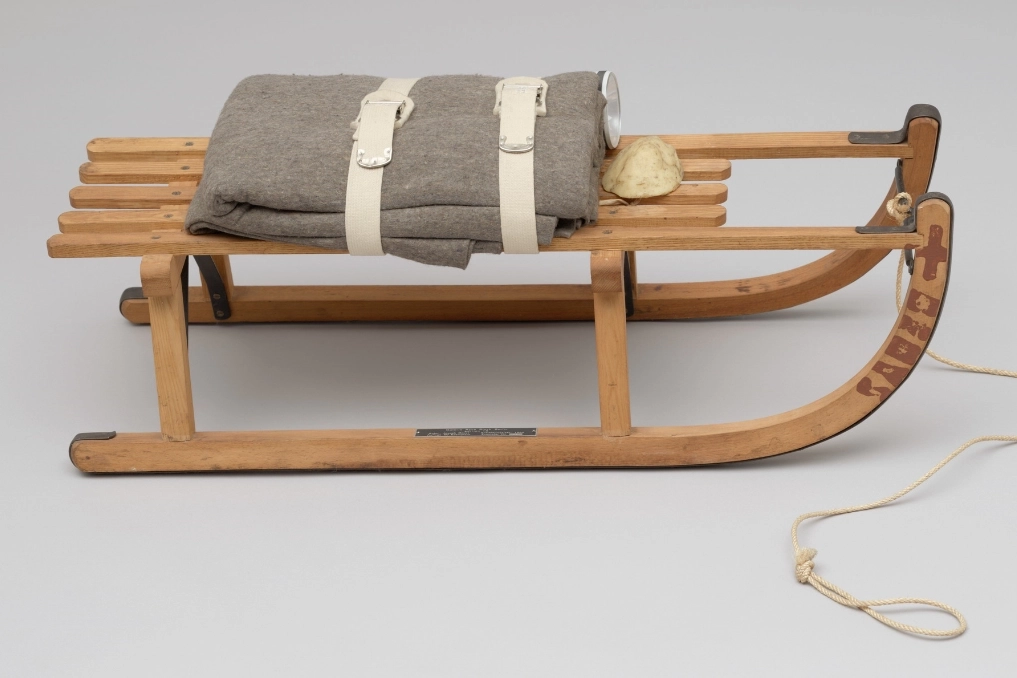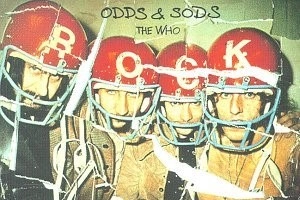Sleds appear quite often in contemporary art installations, but surprisingly less often they are meant to evoke classic associations, i.e. winter and snow. The artists we want to introduce to you today see in this simple instrument, historically one of the first human means of transport, a fairy-tale or mystical object, a symbol of childhood or ancient times, a contrast to today's automotive world or a means of rescue in danger.
If you find yourself in trouble, what would you like to have with you? According to Joseph Beuyshe, it should be these three thingsi – a blanket to keep you warm, protect you against natural elements and to bring you a feeling of home, a flashlight to serve as a lightsource and aid your orientation and a large piece of solid fat for nutrition and insulation.
Sled by Joseph Beuys is an iconic piece of art and tied to it is a famous story from the artist’s life. During the second world war, he was wounded in the middle of the Crimean steppe and a Tatar tribe took him in, and with the use of a sled, a felt blanket and har fat, brought him back to life. There have been many disputes on whether the legend is true, however, the aforementioned attributes have remained in Beuys’ artworks.
.jpg)

In 1969, the same year The Sled was created, Beuys also made an installation of twenty-four sleds called The Pack, which energetically spring forward from the boot of a Volkswagen car and feature the aforementioned symbolic objects. In this work with an ecological subtext, the sled represents an antithesis to the van, a technical achievement of civilisation, but one that would not be nearly as effective as a sled in an extreme emergency. According to Beuys, it is clear that if we want to survive as a species, we must break free from our dependence on industrialisation and reconnect with nature.

Beuys's The Sled served an inspiration for many artists, some of the contemporary ones are, for example, American artist Gregg Gibbs who made a direct parallel to Beuys's work, Winnie Claessens, an artist from Belgium, or German creator Milen Till. His Schlitten (Sled in German), created between 2021 and 2022, are covered with car company logos and comment on the automobile industry and related issues such as sustainability. The object consists of the artist's own childhood sled. He was also inspired to use the car company logos by his memories from when he was a child:
"The old wooden sled is from my childhood. I found them in the bicycle room of the house I grew up in. I often used them to go down a really steep hill, which didn't always turn out well and required a bit of courage. I was part of a little neighborhood gang for a while and we made a lot of mischief. One particularly cheeky and stupid test of courage was breaking off a Mercedes star, which I then kept as a trophy in my bedroom. I still feel remorse to this day. In a way, the combination of these two elements is a reactivation of those childhood memories that involved a certain amount of risk. In principle, art is not very different - with every new work you take a risk."


The sled can be displayed in two ways. Lying down, they are a clear allusion to Joseph Beuys's The Sled, and ideologically point to the past. If the sled is placed vertically, its position resembles a rocket headed into the future.
Canadian artist Rodney Graham's work appropriates a 19th-century painting of a ceremonial royal sleigh that once belonged to Louis II. of Bavaria. The artist placed a projector on a classic children's sled, projecting an image of an ornate winter carriage onto a white wall. The image is endlessly repeated and stripped of its original context. The author reflects on the relationship between an artwork and its social environment. A child's sled automatically evokes memories associated with childhood. The image of the festive sleigh contradicts this experience and offers a completely different picture of reality. The removal of the work from its natural environment is emphasised by the possibility to buy and assemble the entire installation, which the artist offers to those interested.

Paavo Halonen is a Finnish author who achieved fame thanks to his sensitive installations composed of everyday objects from the past. In his work Shaman Drag, a mysterious shamanic figure with an antler crown and a cloak made of colourful strips of fabric journeys into the Spirit World. The sled is pulled by a pair of swans that are meant to symbolise psychopomps, creatures that accompany the souls of the dead into the afterlife. His works raise the question of what meaning does our cultural heritage carry for us today. How much do we have left in common with our past when many of the objects Paavo Halonen uses for his works have become unfamiliar to today's youngest generation of viewers?

Czech author František Skála introduces us to another world of spirits. He first placed his Lesojan, a forest spirit, in his comic Velké Putování Vlase a Brady (The Great Journey of Vlas and Brada), and later created it for everyone to see. The Lesojan has a body made of beech branches, translucent parchment skin, and a single ski that it rides through the trees while glowing. František Skála claims to have really met them and describes them as such: „I love the way Leosians ski on their one ski at dusk. You can't hear them at all. Just an occasional thin whistle before they get going. Even when they're skiing in beech woods on fallen leaves. The kind of forest they come from changes the way their skeleton looks. In spruce, it's made of thin spruce twigs, in beech forests they are made of that sort of wood. Not many people get to see them, so I wanted you to get a closer look.“






